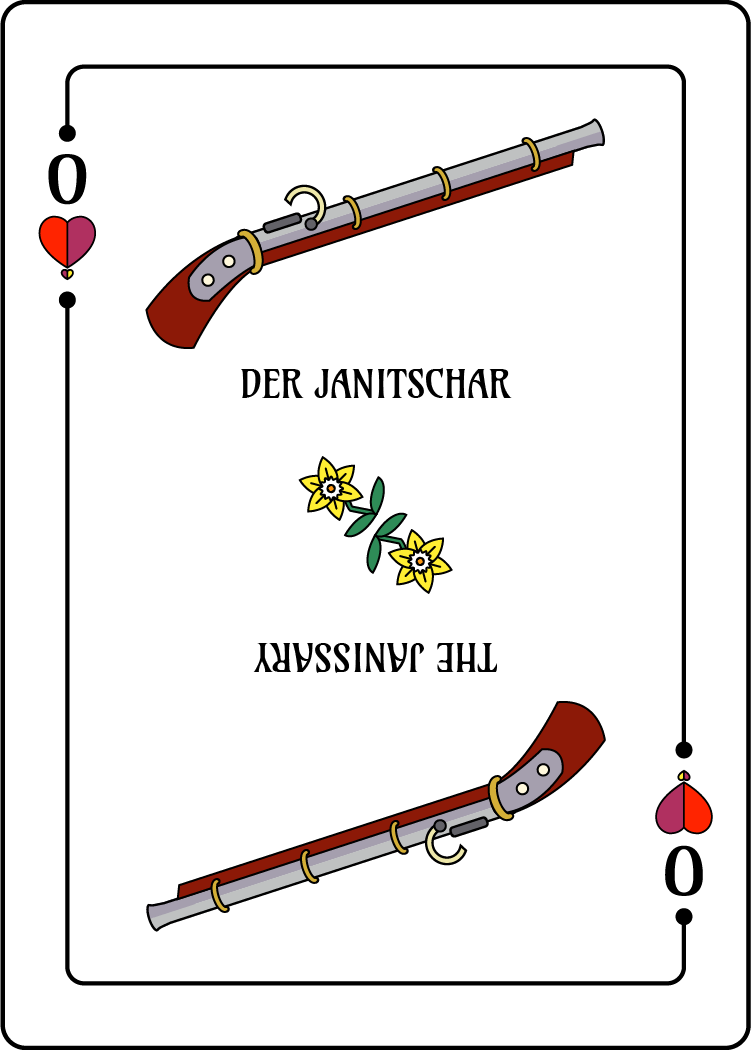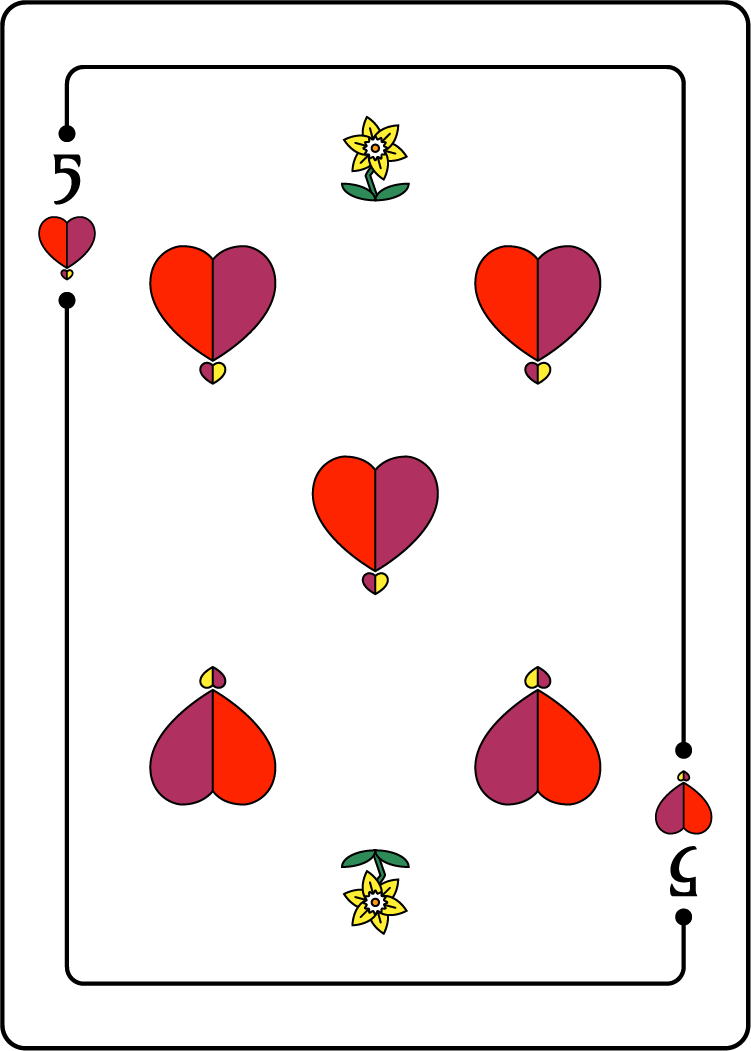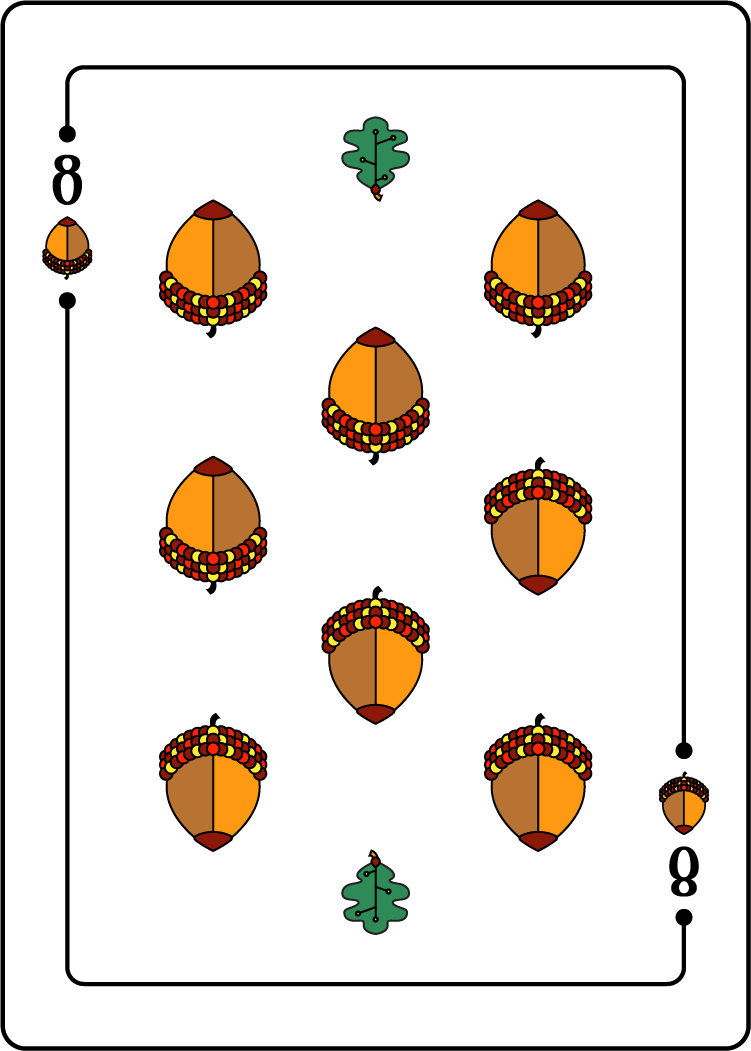Spielkarten
Playing cards inspired by traditional Central European and Pennsylvania Dutch design
Most of us are familiar with contemporary standard playing cards, ones organized with the so-called “French” suits (hearts, clubs, diamonds, and spades) in 52-card decks (A, 2-10, J, Q, K). But this is only one among many regional styles that emerged in Europe starting in the Late Middle Ages. Many of the earlier designs featured quite different suits, fewer cards (32 or 36 depending on the deck), and a broad palette of vivid hues. Even today, you can find colorful German-style cards in southern Germany, Austria, and other parts of Central Europe.
But folks from the English-speaking world can’t use them to play their favorite games: these decks have merged their ace and deuce cards; worse still, the other numbered cards start at 5 or 6, omitting lower numbers entirely. Which got me to thinking…
I wanted to craft a deck that drew on this traditional design (as well as related folk art from my family’s traditions) while also providing the cards needed for the games I know best. The pandemic gave me time to draw, but I only recently came back to the project to build out the final deck. Enjoy!
Standard deck of playing cards with German suits, Salzburger pattern (circa 1800) — Albert Field Collection of Playing Cards, Rare Book & Manuscript Library, Columbia University
About German-style playing cards
If you’re only familiar with modern playing cards, the suits here will certainly strike you as strange. Sure, the hearts are mostly the same, and the leaves have a similar outline to spades. But instead of clubs and diamonds, we’ve got acorns and balls.
Unlike the English suit names, those in German are straightforward and plainly descriptive: Herz (heart), Laub (foliage), Eichel (acorn), and Schellen (jingle bell).
The face cards probably also seem peculiar. The king has no queen, and apparently, the jack has acquired a brother? These last two are called the Ober (“above”) and the Unter (“under”), sometimes depicted as men drawn from two different ranks (like knight and squire, or noble and burgher).
Honoring my artistic roots
The cards’ naive style and bold, primary palette are hallmarks of traditional South German design. Anabaptists from Switzerland and Southwestern Germany carried this aesthetic with them to the British North American colonies, fleeing decades of persecution and pogroms by their Catholic and Protestant neighbors.
The Amish, Mennonites, and other Plain Folk are their descendants. Their distinctive folk art (called Fraktur) decorates barns and covers handicrafts throughout the rich farmlands of SE Pennsylvania — where my mother’s family settled two centuries ago (as part of that diaspora) and where they live to this day. I’ve tried to honor that artistic tradition in the designs shown here.
My re-worked deck
In my design, each König (king) is represented by the crown of a titled ruler, each Ober by the weapon of a warrior, and each Unter by a traditional artisan’s tool. I’ve created true aces, separate from the deuce cards, and added numbers 3 through 6 to yield a 52-card deck. And I’ve matched each suit with an ornament to capture some of the whimsical playfulness of the older designs.
Click the thumbnails or the < and > icons to flip through the card designs for each suit.
Click the thumbnails or the < and > icons to flip through the card designs for this suit.
Herzen (Hearts)
Herzen have the same name and shape in both standard and German decks. I’ve just added a pendant heart to match the general form of the other suits.
ORNAMENT
A narcissus (daffodil), a favorite flower from my Oregonian childhood
KÖNIG
This card draws on the headgear of the Ottoman sultans. They didn’t wear crowns per se, but portraits often show them sporting this sort of jeweled turban.
OBER
Janissaries were elite Turkish soldiers who dominated warfare in the Balkans and Central Europe for centuries. We fancifully associate them with curved scimitars; in truth, they bore early firearms, giving them an edge over European armies still wielding more traditional weapons. (The Ottomans were also early adopters of the cannon, so I considered using some form of artillery instead for this card.)
UNTER
The heavy plow, fitted with a coulter and mould-board (to cut and turn the sod), was the essential farming tool until early modern times.
Eicheln (Acorns)
When playing cards entered Europe (via Italy), they had a suit represented by bastone (cudgel-like batons). “Clubs” is an English calque of this name, confusingly applied to the cloverleaves that the French used in place of the German acorns.
ORNAMENT
An oak leaf, naturally
KÖNIG
Here, the Imperial crown combines elements from different crowns worn by the Holy Roman (later Austrian) emperors.
OBER
Lances weren’t only for displays of toxic machismo at tournaments — these were hard-core weapons designed to skewer anyone in a rider’s path. And that “festive” bunting near the head? Its purpose was to soak up all the blood running down the shaft, so the spear wouldn’t slip from the wielder’s grasp.
UNTER
I’ve cheated and used a mid-19th Century design for the blacksmith’s anvil. Older styles were closer to simple blocks—effective, I’m sure, but lacking in visual appeal.
Click the thumbnails or the < and > icons to flip through the card designs for this suit.
Click the thumbnails or the < and > icons to flip through the card designs for this suit.
Schellen (Bells)
Fashioned from thin metal plates bent around a pebble, crotal bells have a long history. Their ornamental value is pretty clear — but their practical purpose was still greater, giving heedless pedestrians advance warning that a cart or sleigh was upon them.
ORNAMENT
The iris always reminds me of my maternal grandfather, who was especially fond of a dwarf variety that grew in his extensive gardens.
KÖNIG
The Pope was once as much a temporal ruler as a spiritual leader; contemporary Vatican City is all that remains of the once-extensive Papal States that dominated much of central Italy. Today, the traditional papal tiara has given way to the less ostentatious preitosa, an embroidered miter with lappets.
OBER
The Swiss Guard has protected popes since the 16th Century. They’re easily recognized by their iconic halberds, the dual-purpose bêtes noires of mounted knights. Humble foot soldiers could pull a rider to the ground using the weapon’s distinctive hook and then dispatch him with its axeblade or spearpoint—a great equalizer in medieval warfare.
UNTER
The brace and bit is a refinement of the ancient auger, used by carpenters since the time of Christ and his wood-working dad to drill holes in beams and planks.
Laub (Foliage/Leaves)
The Laub suit takes an aspen leaf as its model, a shape also seen in the spades of standard decks. “Spade” isn’t a reference to a gardening tool, by the way. The original Italian suit had swords (spade), and someone had the odd notion of applying that name to what are pretty obviously leaves.
ORNAMENT
Aspens and other members of the poplar family bear flowers in long spikes called catkins. Willows also feature them, hence the “pussy willows” that grow through northern climes.
KÖNIG
“Prince” here means “titled head of state” rather than “son of THoS.” (Junior’s called Prinz in German.) The crown shown here is a simplified coronet gracing the arms of ruling princes in the Holy Roman Empire.
OBER
Although they were deadliest when wielding lances on horseback, knights were most often associated with the longsword. Over time it grew more refined, fit more for ceremony than slaughter, and the 14th-century style shown here emerged about halfway through that transition.
UNTER
“Spinster” originally just meant “a woman who spins” and only later came to mean “never became a wife.” The distaff and spindle twisted fibers (wool, flax, silk, and later cotton) into thread for weaving. Spinning was an almost exclusively female craft, to such an extent that the maternal arm of a family tree is still called the “distaff side.”
Die Spinnerin is the only “female” card in my deck, intended to play the role of the Queen of Spades (the Black Maria, the Old Maid) in games where it has a specific value or function.
Click the thumbnails or the < and > icons to flip through the card designs for this suit.
Distelfink on stylized tulip with eight-pointed stars
[Henry Young (1792-1861)] - Decorator, Daniel Diefenbach (active c. 1825-1873) - Scrivener. Birth and Baptismal Certificate (Geburts und Taufschein) for Catharina McKnight. 1825. Manuscripts. Free Library of Philadelphia: Philadelphia, PA. https://libwww.freelibrary.org/digital/item/6468.
Back of the Card: The Distelfink
The goldfinch, or “thistle finch,” goes by the name Distelfink in the Pennsylvania German dialect and is associated with luck and overcoming adversity (think of navigating the spines of a thistle to get your dinner).
The European goldfinch, a frequent sight in the community’s homelands, was the inspiration for the highly stylized bird appearing on hex signs, ornamented furniture, and other folk arts from the Fraktur tradition. It was also a popular motif in Pennsylvania German birth and baptismal certificates (Taufscheine) during the 1700s and 1800s. As a child, I was fascinated by these semi-mythical creatures: part peacock, part magpie, and entirely winsome.
The lily-like “tulip” of Fraktur art carries meanings of hope, faith, and charity—I’ve added it here as a reminder to poor winners (like myself) to exercise a little humility when playing at cards, especially when the Distelfink brings us good fortune in a game.
























































